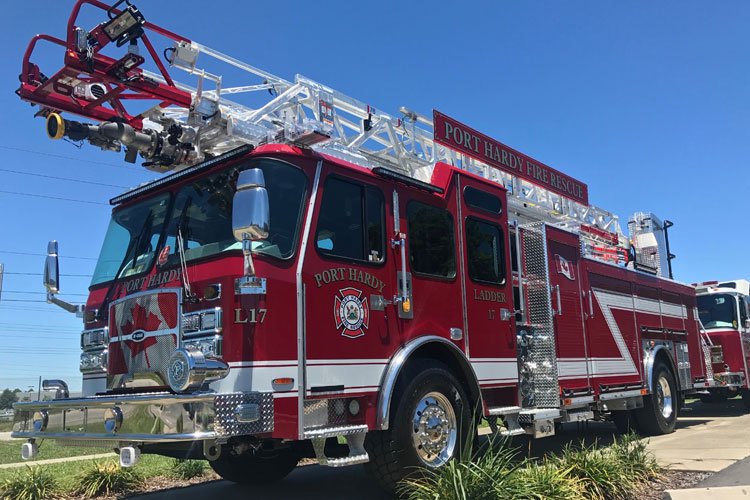Port Hardy (BC) E-ONE HP78 Quint
After a study of high-rise structures in its fire protection district, Port Hardy (BC) Fire Rescue learned it had 18 four-story structures that didn’t allow full access to them as the department didn’t have an aerial device, and the longest ground ladders it carried on its pumpers were 35-foot extension ladders. The department immediately got to work spec’ing out an aerial vehicle.
“We identified what we needed and the specifics of what we were looking for in an aerial truck,” says Brent Borg, Port Hardy’s chief. “Aerials aren’t built in Canada, so we sent out six tender packages to aerial manufacturers in the United States and chose E-ONE because its vehicle fit the bill of what we wanted.”
The resulting vehicle built by E-ONE for Port Hardy is an E-ONE HP78 eMAX quint on a Typhoon X chassis and medium cab with a 58-inch cab-to-axle length and 3/16-inch aluminum construction with roll-cage type design that, according to Joe Hedges, E-ONE’s product manager for chassis and aerials, “exceeds NFPA requirements by five times.” The cab has frontal and roll-technology side air bags, seat belt pretensioners, and seating for six firefighters with the crew cab having two rear-facing seats and two forward-facing.
Hedges points out the quint’s frame is “12-inch double rail Galvanized steel and powder-coated for enhanced corrosion resistance, and the aluminum aerial will never need paint and will never rust. The HP78 is a single-axle product with a ToughTruss™ ladder design that features extruded aluminum construction with a 2.5:1 structural safety factor and a 825-pound tip load. The aerial has a full wireless aerial control package, so it can be operated from a remote distance as well as from the turntable.”
He adds that the tip of the aerial carries an Elkhart Brass wireless Cobra EXM 1,000-gpm monitor, and a Task Force Tips VUM (Valve Under Monitor), as well as a lifting eye. Blue Amdor Pathfinder strip lighting is strung along the aerial’s length. “The HP78 has two H-style jacks with a 16-foot jack spread that can be short jacked,” Hedges says. “The ladder can be rotated 10 degrees to the short jack side to get a little more range and also has an alley jack mode where both jacks drop straight down and allow the ladder to rotate 180 degrees so it can operate 10 degrees on either side of center in tight spaces.”
Ian Manly, apparatus services salesman with Associated Fire Safety, who sold the quint to Port Hardy, says that the fire department’s truck committee “knew exactly what they wanted in the truck and really wanted to have the wireless aerial controls because the whole truck—from the aerials to the jacks—can be operated wirelessly.” Manly notes that Port Hardy’s truck committee “also liked the eMAX design with the roll-up door over the pump panel and the speedlays down low because that configuration allowed us to maximize compartment space on the vehicle.”
The E-ONE HP78 eMAX quint carries a 1,585-gpm single-stage pump, a 470-gallon water tank with a 30-gallon integral foam tank, and an FRC PumpBoss PBA400 pressure governor. Lighting on the vehicle includes Whelen’s 600 series Super LED lower level warning light package and Whelen 600 series gradient Super LED surface-mounted scene lights.
Borg points out that Port Hardy wanted all LED lighting on the aerial so there was no need for a generator, although the department carries a portable generator for use away from the truck. “By going with LED lighting, we were able to double the amount of lights from our past specifications but still stayed within the capacity of the alternator of the truck,” he says.
Borg notes that the department took delivery of the quint in May 2018 and trained on it for six weeks. “In the first week we had the quint in service, we used it for three working calls: a fourth story apartment fire, a roof fire, and a rescue off of a high school roof,” Borg says. “At the fourth-floor apartment fire, which happened three days after we put the quint in service, we had 13 firefighters initially on the scene, and as the crews were setting up, the aerial operator ran the truck by himself, got water flowing to the fourth floor, and saved the building. He was able to position himself with the wireless controls to get water in the apartment building window, hit it once, and knock the fire out.”
ALAN M. PETRILLO is a Tucson, Arizona-based journalist, the author of three novels and five nonfiction books, and a member of the Fire Apparatus & Emergency Equipment Editorial Advisory Board. He served 22 years with the Verdoy (NY) Fire Department, including in the position of chief.






